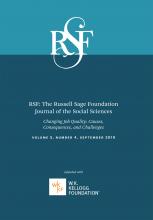Research Article
Open Access
The Wage Mobility of Low-Wage Workers in a Changing Economy, 1968 to 2014
Michael A. Schultz
RSF: The Russell Sage Foundation Journal of the Social Sciences September 2019, 5 (4) 159-189; DOI: https://doi.org/10.7758/RSF.2019.5.4.06
Michael A. Schultz
adoctoral candidate in sociology at the University of North Carolina at Chapel Hill

REFERENCES
- ↵
- Acemoglu, Daron, and
- David Autor
- ↵
- Aertz, Bodo, and
- Nicole Gürtzgen
- ↵
- ↵
- Andersson, Fredrick,
- Harry J. Holzer, and
- Julia I. Lane
- ↵
- ↵
- Bernhardt, Annette,
- Rosemary Batt,
- Susan Houseman, and
- Eileen Appelbaum
- ↵
- Bernhardt, Annette,
- Martina Morris,
- Mark S. Handcock, and
- Marc A. Scott
- ↵
- Bolvig, Iben
- ↵
- Boushey, Heather
- ↵
- Brady, David,
- Regina Baker, and
- Ryan Finnigan
- ↵
- Campbell, Colin
- ↵
- Cappellari, Lorenzo
- ↵
- Cappelli, Peter
- ↵
- Card, David, and
- John E. DiNardo
- ↵
- Carrington, William J., and
- Bruce C. Fallik
- ↵
- Cha, Youngjoo, and
- Kim A. Weeden
- ↵
- Cockx, Bart, and
- Matteo Picchio
- ↵
- Connolly, Helen,
- Peter Gottschalk, and
- Katherine Newman
- ↵
- ↵
- England, Paula
- ↵
- Farber, Henry S.
- ↵
- Flood, Sarah,
- Miriam King,
- Renae Rodgers,
- Steven Ruggles, and
- J. Robert Warren
- ↵
- Frank, Robert
- ↵
- Freeman, Richard B., and
- James L. Medoff
- ↵
- French, Eric,
- Bhashkar Mazumder, and
- Christopher Taber
- ↵
- Gangl, Markus
- ↵
- Gash, Vanesa
- ↵
- Gathmann, Christina, and
- Uta Schönberg
- ↵
- Gautié, Jérôme, and
- John Schmitt
- ↵
- Goldin, Claudia, and
- Lawrence F. Katz
- ↵
- ↵
- Grieger, Lloyd,
- Sheldon H. Danziger, and
- Robert F. Schoeni
- ↵
- Hacker, Jacob
- ↵
- Handwerker, Elizabeth W.
- ↵
- Handwerker, Elizabeth W., and
- James R. Spletzer
- ↵
- Heathcote, Jonathan,
- Fabrizio Perri, and
- Giovanni L. Violante
- ↵
- Heckman, James, and
- Burton Singer
- ↵
- Heinze, Anja, and
- Nicole Gürtzgen
- ↵
- Holmes, Craig, and
- Gerbrand Tholen
- ↵
- Horowitz, Jonathan
- ↵
- ↵
- Hunt, Jennifer, and
- Ryan Nunn
- ↵
- Jarvis, Benjamin F., and
- Xi Song
- ↵
- Kalleberg, Arne L.
- ↵
- Kalleberg, Arne L.
- ↵
- Kalleberg, Arne L.
- ↵
- Kalleberg, Arne L.
- ↵
- Kalleberg, Arne L., and
- Ivar Berg
- ↵
- Kalleberg, Arne L., and
- Ted Mouw
- ↵
- Kalleberg, Arne L.,
- Barbara F. Reskin, and
- Ken Hudson
- ↵
- Kalleberg, Arne L.,
- Jeremy Reynolds, and
- Peter V. Marsden
- ↵
- Kambourov, Gueorgui, and
- Iourii Manovskii
- ↵
- Knabe, Andreas, and
- Alexander Plum
- ↵
- Kronberg, Anne-Kathrin
- ↵
- ↵
- Latner, Jonathan P.
- ↵
- ↵
- Mason, Geoff, and
- Wiemer Salverda
- ↵
- Massey, Douglas S., and
- Deborah S. Hirst
- ↵
- ↵
- McKnight, Abigail,
- Kitty Stewart,
- Sam Mohun Himmelweit, and
- Marco Palillo
- ↵
- Mills, Melinda
- ↵
- Mishel, Lawrence,
- Heidi Shierholz, and
- John Schmitt
- ↵
- Mood, Carina
- ↵
- Mosthaf, Alexander,
- Claus Shnabel, and
- Jess Stephani
- ↵
- Mouw, Ted, and
- Arne L. Kalleberg
- ↵
- Mouw, Ted, and
- Arne L. Kalleberg
- ↵
- Newman, Katharine
- ↵
- Organization for Economic Cooperation and Development (OECD)
- ↵
- Pager, Devah
- ↵
- Panel Study of Income Dynamics (PSID)
- ↵
- Pavlopoulos, Dimitris, and
- Didier Fouarge
- ↵
- Pavlopoulos, Dimitris,
- Didier Fouarge,
- Ruud Muffels, and
- Jeroen K. Vermunt
- ↵
- ↵
- Ren, Chunhui
- ↵
- Salverda, Wiemer, and
- Ken Mayhew
- ↵
- Sanders, Carl
- ↵
- ↵
- ↵
- Smith, Chelsea,
- Robert Crosnoe, and
- Shih-Yi Chao
- ↵
- Sørensen, J. B.
- ↵
- Stewart, Mark B., and
- Joanna K. Swaffield
- ↵
- VanHeuvelen, Tom
- ↵
- Weil, David
- ↵
- ↵
- Western, Bruce,
- Deirdre Bloome,
- Benjamin Sosnaud, and
- Laura Tach
- ↵
- Williams, Richard
- ↵
- Wilson, George, and
- Vincent J. Roscigno
- ↵
- Wren, Anne
- ↵
In this issue
The Wage Mobility of Low-Wage Workers in a Changing Economy, 1968 to 2014
Michael A. Schultz
RSF: The Russell Sage Foundation Journal of the Social Sciences Sep 2019, 5 (4) 159-189; DOI: 10.7758/RSF.2019.5.4.06





